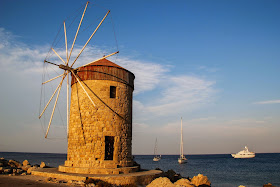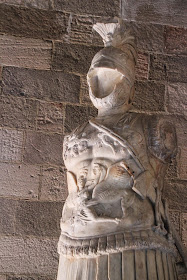One of the huge perks of my job is the opportunity to travel. In September 2014, I was part of an international collaboration that culminated in a conference in the ancient city of Rhodes , Greece, on the island of the same name (Ρόδος - pronounced Rodos - in Greek). This post will focus on the city itself and its long and rich history.
Greece. This country may have some severe economic issues, but it is rich in so many other things. Its ancient culture is proud and rich, and it boasts some of the most beautiful land- and seascapes in the world. Flying from Athens to Rhodes over the island-sprinkled Aegean Sea is a good way to develop some appreciation for Greece's geophysical wealth. The topographically complex islands shoot up out of the sea, teasing from below with their intricate coastlines and glowing beaches.
As with much of Greece, and all the rest of its islands, Rhodes is intimately connected to the sea. Rhodes' famous harbor is testament to this. Unfortunately, the Colossus of Rhodes, one of the 7 Wonders of the Ancient World, no longer stands astride the entrance of the harbor, but there are still plenty of ancient and very old sites to see around the city. The windmills along the harbor, one of which is seen here, are one example of some remnants of the past. Windmills are common on Greek islands, allowing islanders to benefit from the strong, near-constant winds that travel down the Aegean much of the year.
As I've already mentioned a couple of times now, Rhodes has a very rich and long history. The old city is one of Europe's best preserved examples of a medieval walled city. Rhodes was founded during the Classical Greek period during the fifth century B.C.E. However, the walls that you see around the city today are not remnants of that ancient time; they are from the Middle Ages and the Renaissance, when Rhodes went from being a Byzantine to a Christian Crusader (under the rule of the Knights Hospitallers) to an Ottoman city. Needless to say, with its strategic position between Europe, the Middle East, and North Africa and its well established harbor and fortified city, Rhodes was a strategic objective and one of the focal points of ancient and medieval history.
The complete walls around the city are very impressive. Rhodes is one of those special places in the world that actually make you feel as if you've been transported back to a different time.
One of the few gateways through the walls to the old city.
Inside the old city, "old" is definitely an accurate adjective for just about all of the architecture. It would be brilliant to see some kind of time lapse video of the city itself and how it has evolved and changed over the centuries... with the most impressive aspects being some of the oldest features and how they have endured the trials and tribulations of time.
Inside the old town, most of the main streets are named after famous Greeks. Some examples include: Sokratous (Socrates), Omirou (Homer), Perikleous (Pericles), Sofokleous (Sophocles), Aristotelous (Aristotle), and Pythagora.
One of my favorite things about the city is the seemingly random mixture of different architectural styles and features. The Greek, Roman, Byzantine, medieval, Ottoman, and Italian styles are all present in one form or another around town. This owl statue at the top of a fountain in one of central squares was one of my favorite features.
Rhodes' clocktower. This old structure offers some great views over the old city. Note too that unlike the blue domes seen around many of the Greek islands, Rhodes has gone for red.
Oh, and that's something you don't see too often in Western Europe, an old mosque. Thanks to the Ottoman influence on the city, there are several huge mosques around the old town plus several Turkish bath houses.
I loved the candy striping on this mosque, though it was in a sad, yet charming state of disrepair.
These domes made me feel almost like I was in Turkey...
Signs of the Ottoman rule are all over... like these public washing stations.
Looking up the Ippoton, or the Gothic Street of the Knights. This is one of the remnants of the medieval period, when the Knights Hospitallers ruled Rhodes.
Many countries from Western Europe had their own "knight's house" along this street. The reason for this? The armies of the Crusades were made up of knights from many countries, speaking many languages. These houses offered a little taste of home while they were away crusading.
Looking back down the street from the top.
And just around the corner at the top of the Street of Knights is the Palace of the Grand Masters.
Unlike the facade (previous pictue), the Palace's interior is not at all true to the original, which was destroyed by an ammunition explosion (triggered by a lightning strike) in the mid-1800s. Under Italian occupation in the early 1900s, the palace was reconstructed as a summer retreat for Mussolini. Supposedly, however, the Fascist leader never spent any time on Rhodes.
There is no denying that the restoration is beautiful though.
The main courtyard of the Palace. You can tell several things in here... first, that this structure isn't so old as the renovators might have liked you to believe and second that this isn't quite so Greek either.
Inside the Palace is kind of like a small museum.
These mosaics are just amazing. They are Greek, having been moved by the Italians from elsewhere in Greece as decoration.
I'd love to know what master laid these out and see the process for constructing such mosaics. They are incredible works of relatively utilitarian art.
Then there were touches like this... they just don't fit in the medieval style of the place. But I guess you have a lot of that in old European castles and palaces.
These merlons, seen around various parts of the city fortifications, reminded me a lot of Morocco and its casbahs.
Back on the streets... the oh so very charming and romantic streets.
There is no doubt that Rhodes is a very romantic city. There were couples all over the place enjoying strolls around the labyrinthine old town.
Wandering around the old town, you are surrounded by character oozing out of pretty much everything. What is it about a certain state of decay that is just so charming and endearing?
My favorite part about the old town were all the signs that people, actual Greek people, really still live there. Unlike so many major tourist destinations, which have managed to push out so many of their locals due to explosive real estate costs and competition to hotels and other tourist accommodations, Rhodes is still very much a locals city. I loved that. It makes you feel so much more authentic, and less like you are just in some theme park, when you see locals going about their daily routines.
Wandering around the old city, you'll notice these arches between buildings. These are actually earthquake supports. Over the millennia, the architects and engineers of Rhodes have learned how to safeguard against the seismic activity that has rocked their city so many times in the past. In fact, it was an earthquake that toppled the ancient wonder of the Rhodes Colossus.
I like doors, and Rhodos has some cool doors... I just couldn't leave these out. I swear, I should make a coffee table book of the doors of the world or something...
The wreath above this door was a pretty common feature around town. The subtle pastel colors in it contrasted so well with the bright paints on the facades.
Speaking of those bright paints, I just loved the mess around this door in a back alley.
Now onto food. Being a tourist destination, there are tavernas all over the place in the old city, many of which offer some great options for food. However, some of the best food we ate was actually outside the old city in the new city that surrounds it. Though, you can't really beat sitting and enjoying a drink and some small bites surrounded by the ancient charm of the old town.
The food in Rhodos was good and very standard Greek, and the seafood was fantastic.
There are also a few rooftop bars and some great nightlife around town. One of my favorite spots was in a square adjacent to the Ibrahim Pasha Mosque. There were a bunch of great little cafes and bars there around the square, which was just a perfectly atmospheric place to enjoy a nice cool beer and some deliciously flavored nargile (Turkish water pipe with flavored tobacco) on a warm Rhodian night.







































No comments:
Post a Comment